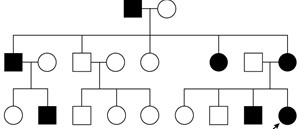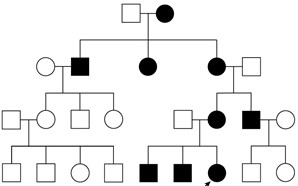A 19-year-old woman is evaluated for new onset generalized tonic-clonic seizures. For the past several years, she has also been having erratic jerks of her arms and legs, and intermittent muscle weakness. The girl has multiple family members with similar symptoms. Neurological examination reveals decreased sensation in the lower extremities and a broad-based gait. Skeletal muscle biopsy shows ragged, red-appearing muscle fibers. Further analysis reveals that the patient's symptoms are due to a mutation affecting extranuclear DNA. Which of the following pedigrees is most likely to represent this patient's family history? (The arrow points to the patient.)
A) 
B) 
C) 
D) 
E) 
Correct Answer:
Verified
Q51: A 46-year-old woman is evaluated for a
Q52: Molecular biologists are investigating the functional significance
Q53: A study is undertaken to map the
Q54: In an experiment, cultured fibroblasts are mechanically
Q55: A 26-year-old woman comes to the office
Q57: A 5-year-old boy is being evaluated for
Q58: A 43-year-old man is evaluated for progressive
Q59: A researcher develops 2 functional mRNA sequences
Q60: A 34-year-old woman comes to the office
Q61: In an experiment, erythrocyte precursor cells are
Unlock this Answer For Free Now!
View this answer and more for free by performing one of the following actions

Scan the QR code to install the App and get 2 free unlocks

Unlock quizzes for free by uploading documents